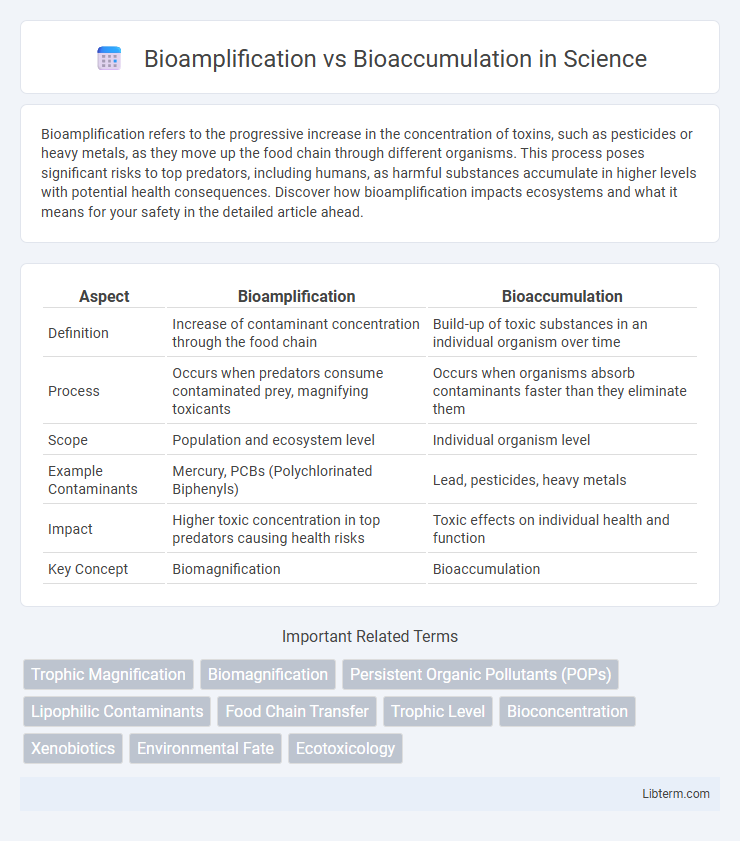Bioamplification refers to the progressive increase in the concentration of toxins, such as pesticides or heavy metals, as they move up the food chain through different organisms. This process poses significant risks to top predators, including humans, as harmful substances accumulate in higher levels with potential health consequences. Discover how bioamplification impacts ecosystems and what it means for your safety in the detailed article ahead.
Table of Comparison
| Aspect | Bioamplification | Bioaccumulation |
|---|---|---|
| Definition | Increase of contaminant concentration through the food chain | Build-up of toxic substances in an individual organism over time |
| Process | Occurs when predators consume contaminated prey, magnifying toxicants | Occurs when organisms absorb contaminants faster than they eliminate them |
| Scope | Population and ecosystem level | Individual organism level |
| Example Contaminants | Mercury, PCBs (Polychlorinated Biphenyls) | Lead, pesticides, heavy metals |
| Impact | Higher toxic concentration in top predators causing health risks | Toxic effects on individual health and function |
| Key Concept | Biomagnification | Bioaccumulation |
Introduction to Bioamplification and Bioaccumulation
Bioamplification refers to the increasing concentration of toxins, such as heavy metals or pesticides, as they move up the food chain, impacting higher trophic levels more severely. Bioaccumulation describes the gradual buildup of toxic substances within an individual organism over time through direct exposure or consumption of contaminated food. Both processes highlight critical environmental concerns related to pollutant persistence and ecological health risks.
Defining Bioaccumulation: Key Concepts
Bioaccumulation refers to the gradual buildup of toxic substances, such as heavy metals or pesticides, within an organism over time through direct exposure to contaminated water, food, or air. Unlike bioamplification, which involves the increase in contaminant concentration across trophic levels in a food chain, bioaccumulation occurs at the individual level. Understanding key concepts of bioaccumulation is essential for assessing environmental risks associated with persistent pollutants and their long-term effects on wildlife and human health.
Understanding Bioamplification: Essential Overview
Bioamplification refers to the increasing concentration of toxic substances like heavy metals or pesticides as they move up the food chain, impacting higher trophic levels more severely. Understanding bioamplification involves recognizing how pollutants biomagnify through predator-prey relationships, leading to amplified toxicity in apex species such as eagles or humans. This process contrasts with bioaccumulation, where contaminants build up within a single organism over time rather than increasing in concentration across multiple trophic levels.
Bioaccumulation Process: How Contaminants Build Up
Bioaccumulation occurs when organisms absorb contaminants faster than they can eliminate them, causing toxins like heavy metals and persistent organic pollutants to concentrate in tissues over time. This process is driven by exposure through contaminated water, food, or sediment, enabling substances to progressively increase within individual organisms. Unlike bioamplification, which refers to increasing concentrations through trophic levels, bioaccumulation focuses on contaminant buildup within a single organism throughout its lifespan.
Bioamplification in Food Chains: Mechanisms Explained
Bioamplification occurs when toxic substances, such as heavy metals or persistent organic pollutants, increase in concentration as they move up trophic levels in a food chain. Predatory species ingest prey containing contaminants, leading to higher toxin loads in top predators due to biomagnification processes. This mechanism significantly impacts ecosystems by amplifying pollutant effects, resulting in health risks for wildlife and humans at the apex of food chains.
Comparison: Bioaccumulation vs Bioamplification
Bioaccumulation refers to the gradual buildup of toxins in an individual organism's tissues over time, while bioamplification, also known as biomagnification, describes the increase in toxin concentration as they move up through trophic levels in a food chain. Bioaccumulation affects single organisms and occurs through direct exposure or consumption, whereas bioamplification impacts entire ecosystems by magnifying toxin levels from prey to predator. Understanding the distinction highlights the ecological risk of persistent pollutants like mercury and PCBs, which bioaccumulate in organisms and bioamplify across food webs, resulting in heightened toxicity in apex predators.
Real-World Examples of Bioaccumulation
Bioaccumulation occurs when organisms absorb toxic substances, such as mercury or polychlorinated biphenyls (PCBs), faster than they can eliminate them, leading to increased contaminant levels in tissues over time. A prominent real-world example is the accumulation of mercury in fish species like tuna and swordfish, posing significant health risks to humans who consume them. This process contrasts with bioamplification, where contaminant concentrations increase up the food chain, often exemplified by the higher mercury levels observed in predatory birds such as eagles.
Case Studies Highlighting Bioamplification
Case studies on bioamplification reveal increasing concentrations of pesticides like DDT in predatory birds such as the bald eagle, leading to eggshell thinning and population decline. Research in aquatic ecosystems demonstrates mercury bioamplification through the food chain, with top predators like tuna exhibiting harmful toxin levels affecting human health. These case studies emphasize bioamplification's role in magnifying pollutants at higher trophic levels, contrasting with bioaccumulation where toxins accumulate within individual organisms over time.
Environmental and Health Impacts
Bioamplification significantly increases toxin concentrations as they move up the food chain, posing severe risks to apex predators and humans by causing neurological damage and reproductive issues. Bioaccumulation results in toxin buildup within individual organisms over time, leading to chronic health problems such as immune system suppression and developmental defects. Both processes disrupt ecosystems and biodiversity, highlighting the urgent need for stringent pollution control and environmental monitoring.
Prevention and Mitigation Strategies
Prevention and mitigation strategies for bioamplification focus on reducing the release of persistent organic pollutants such as mercury and PCBs into ecosystems by enforcing stringent industrial regulations and promoting the use of safer chemical alternatives. Bioaccumulation mitigation emphasizes minimizing individual exposure by managing contaminated habitats, implementing safe waste disposal, and restoring affected wildlife populations through habitat restoration and pollution control measures. Monitoring programs and public education campaigns are essential for both processes to track pollutant levels and encourage sustainable environmental practices.
Bioamplification Infographic

 libterm.com
libterm.com